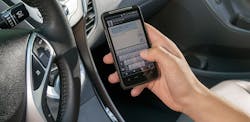Keeping your drivers focused in a world of distractions
Fuel prices are down, fuel-efficiency technologies are thriving, and that means big savings in fuel costs for trucking and the rest of the motoring public. That’s a good thing for fleets, right? It depends on how you look at it.
Low fuel prices nationwide mean more vehicles on the road. And, according to Christopher Hayes, second vice president of Risk Control, Transportation Services at Travelers, it’s all happening in an environment where more distractions abound.
“We see increased distraction at a time with more cars and vehicles on the road,” Hayes explained in an interview with Fleet Owner. “It is leading to part of the increase in fatalities and accidents in the last few years. There’s more people driving and they’re less focused on their driving. Distracted driving is one of the biggest risks out there.”
Distractions include cell phone and technology usage while driving, problems at home, lack of sleep or fatigue, mind wandering, or any other issue or device that keeps a driver’s attention from the road. In recognition of Distracted Driving Awareness month (this April), Fleet Owner spoke with Hayes and Drew Schimelpfenig, product manager with Omnitracs Safety Center of Excellence, to provide some tips and insight as to how fleets and their drivers can stay focused and defend themselves against avoidable accidents.
What are some distracted driving trends/risky driving behaviors to note?
Schimelpfenig said that based on data Omnitracs has collected and analyzed over the past 10 years, distracted driving is the root cause of 87% of motor vehicle crashes. He added that the number one reason for distracted driving is inattention, and he warns truck drivers not to be complacent.
Noting the numbers support that the industry as a whole has made vast improvements when it comes to safety, Schimelpfenig mentioned that truck driving is the only profession he can think of in which professionals share their work space with those who are far less trained.
“The vast majority of [truck] drivers are very proud of their craft and their profession – and they have to share the road with us,” he said. “It’s a very interesting work environment and a challenging situation anytime a professional driver has to share the road with other drivers out there.”
The National Safety Council identified some of the top driver behaviors and beliefs that put all roadway users at risk and increase the likelihood of being involved in a crash. According to NSC, some of the top distressing things drivers do – or believe they can do – include:
- 47% of drivers believe it is safe to send a text either manually or via voice-dictation systems.
- 45% say they feel pressure from employers to check email while driving; however, 44 percent say they have crashed in the last three years while they were either commuting or traveling for business.
- 35% of teens would use social media behind the wheel.
- 17% of teens feel their own distraction may have contributed to a crash.
- 71% believe they can have up to 3 drinks before they are not safe or too impaired to drive.
- 33% believe it is acceptable to drive with less than four hours of sleep. NSC notes that drivers who are tired can be as impaired as drivers who are legally drunk.
- 32% say new cars can essentially drive themselves.
- 13% have driven after using marijuana in the last month.
How about some best practices and tips for fleets and their drivers?
Schimelpfenig suggests truck drivers play the “what-if” game to help stay focused. The “what-if” game is a training tool some of his fleet customers and drivers have used to practices defensive driving techniques to avoid accidents.
“They are constantly looking ahead and at drivers of other vehicles,” he explained. “They are constantly asking themselves, ‘What if that driver has to switch lanes, or what if that equipment falls off that trailer.’ They play that game to keep alert, and they’re ready to respond. Situational awareness is obviously key.”
Video is another tool fleets can use to help improve driving habits. When used as a training tool, Schimelpfenig noted fleets let drivers learn from other drivers and from their own experiences. In addition, he said as new drivers are hired, it is helpful to pair them with and learn from the fleet’s more experienced drivers.
Hayes stressed that telematics devices and in-cab videos should be used to coach driver behavior rather than as a punitive action. He urges fleets make the move now to coach their drivers and set up driver scorecards or some other tool to help them understand how their performance can turn the fleet’s overall safety around.
“We’ve dealt with fleets that have a sense that if drivers know there is some sort of tracking going on in their vehicle, it will [automatically] encourage tracking and driving behavior,” Hayes pointed out. “We had one fleet that used cameras in the vehicle, and they saw no results in a year. When we sat down and asked about coaching, they hadn’t done that. They just thought the presence of the camera would take care of it.”
“The ability to take that video footage from a camera system and present it to a driver and use it as a coaching tool and engage with your employees will really drive behavior,” he continued.
Hayes offered a few more tips for fleet managers and drivers:
- Cell phone blockers could be useful in terms of reducing distraction.
- An in-cab camera system will pick up if a driver used a cell phone, and the manager will pick up on that.
- Rule of thumb: When using GPS, always set have your driver set his or her destination before he or she leaves. Mount the phone or device so it remains hands-off through the drive.
- Always watch where you’re going. The most common sources of accidents its some common form of inattention.
- Take a break if you need to and get back on the road when you’re able to.
- Practice defensive driving and think about everyone else around you.
- Practice what you preach. “We’ve seen fleets that really push messages around their drivers but don’t do things internally,” Hayes explained. “We’ve seen situations when a dispatcher is calling a driver when the driver is on the road. Spend as much time talking to the staff internally about your distracted driving policy and safety culture within the company. Make that safety work inside the four walls as well as inside the vehicle.”
Omnitracs also came up with a few tips to help drivers stay focused on the road:
- Mobile technology – Acceptable use policy for mobile technology should be carefully considered, clearly communicated and consistently executed, Schimelpfenig said. The most successful implementations for zero tolerance included involving the family of the drivers asking that they support their loved ones by not talking with their drivers while they were behind the wheel. It is also important that operations follow the same policy and not talk with drivers if they are driving or attempt to contact them if they know they are still on the road.
- In-cab technology – According to Schimelpfenig, in-cab technology that is expected to be used while driving should be installed so drivers can see it and the road at the same time. User interfaces, displays and monitors should never block view of road, mirrors or windows. Treating these additional interfaces as an additional gauge and ensuring that they are never installed any lower than other instrumentation in the dash of the vehicle allows the driver to quickly check the information from these displays as easily as they can check mirrors or dashboard gauges.
- Navigation – When leveraging a navigation solution, the solution must help the driver to navigate to his or her destination in a non-distracting fashion, said Rick Turek, Chief Navigation Scientist, Omnitracs. “To this end, the navigation solution must consider the vehicle's and load's profile when generating safe and easy to follow directions,” he said. “The bottom line is a lost driver is a distracted driver, and a distracted driver is a dangerous driver.”
About the Author

Cristina Commendatore
Cristina Commendatore is a past FleetOwner editor-in-chief. She wrote for the publication from 2015 to 2023.


